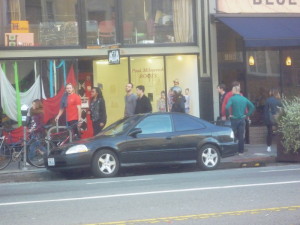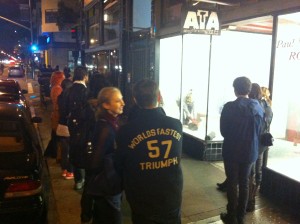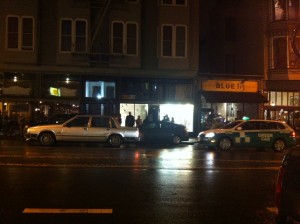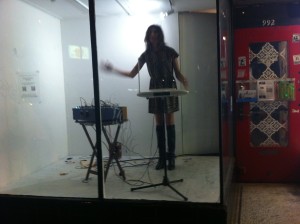
“In the pieces that I watched from outside, I felt a push and pull from the glass membrane. It felt vulnerable for me as a viewer… a step of trust to make contact with hand or eyes with performer, or come close to it.” -Laurie Buenafe Krsmanovic

 For the month of November, 2014, ATA’s window was animated by daily inhabitancies. Each day, a different artist or group of artists installed themselves in the storefront window, occupying it for a range of one to 48 hours. Their actions varied from just being there to performing music to outraged/ous splattering of substances. In the words of the ATA Window Gallery curators it was “a series of installed performances ranging from movement to musical, ritual to reenactment, interactive to endurance.”
For the month of November, 2014, ATA’s window was animated by daily inhabitancies. Each day, a different artist or group of artists installed themselves in the storefront window, occupying it for a range of one to 48 hours. Their actions varied from just being there to performing music to outraged/ous splattering of substances. In the words of the ATA Window Gallery curators it was “a series of installed performances ranging from movement to musical, ritual to reenactment, interactive to endurance.”
Busting up the original architectural purpose – merchandising – of the display window, these artists tweaked the power mechanics of subject/object. By implementing the corporeal gaze to stop people in their tracks, they oscillated between Observed and Observer. Merely by their physical presence, they ruptured the usual experience of public visual space along the increasingly consumption-based Valencia Corridor. It’s always a surprise to see a live person or animal in a shop window, but prolonged observation of these events revealed additional layers that confound Capital, Culture, and Meaning.
Any kind of performance or action has a potential performer and viewer, roles that can be reversed or shared: by stopping and watching, the passersby also observed one another reacting to the people in the window. Aptly entitled “Almost Public/Semi-Exposed,” the series caused the window glass to function as a permeable “glass membrane,” creating and transmitting street-level information that was radically different from the usual.
Most of us have encountered “live mannequins,” animals up for adoption, or shop cats dozing in store windows, but the things these artists were doing were unusual, odd, mesmerizing, and/or shocking to those who saw them. Most of the passersby have not, nor will they ever, attend performances (some of the artists do not use this word to describe their work) like these. We are all generally aware of the performative behaviors of acting, dancing, singing, athletics, speeches, lectures, announcements; corporate behaviors like selling/customer service/serving; and controlling actions by agents of power. A few of us have seen Butoh, most have seen musicians perform, but few have seen a woman play the touchless, motion-driven Theremin or have been invited to participate in a drawing exchange, especially not in a storefront window.
Conformity is of high importance in our society (and probably in most societies, really), but it underlies the “innovation,” “creative” as noun instead of adjective, and “thinking different” – key faux initiatives in the current occupying force in San Francisco. Most people in this country are using digital interaction at an increasing level, and of course many of the people on Valencia Street also work in the digital technology industry. Person to person encounters are mediated either directly in practice or indirectly by the lasting effects of digital communication, so to see a person in the flesh in this “almost public” context is a shock. In a discussion of algorithm-guided composition based on already popular music, an evolutionary psychologist might say that the recognizable is not perceived as dangerous. And the inscrutability of these window presences repelled some, but attracted many. It was fresh and enlivening to watch a person so intensely “being” in a public display. Mostly anonymous, these artists appeared for free. Karen Finley, commenting on the book “I’m Trying to Reach You,“mentions our “desire for interconnectivity…and…what it means to strive, cope, and love with all of our heart, brain, body and soul…” – these artists did all of that; it’s what enabled them to put themselves in such a vulnerable position, and to create such powerful experiences. Some of the public were disturbed or enraged by their presence, possibly because the artists’ position as Objects (viewed) was too unstable: the Subjects (viewers) really had no control over what they saw. They did not pay, so could not own the performers; the capitalist impulse was thwarted. No explanation was given, so they had to open up to the shock of the now. Utterly autonomous, these intractable artists created a space of agency that left viewers the choice of whether, and for how long, to continue to look.
-Claire Bain
For photos and excellent commentary by the performers, see the Artists Television Access blog post

No comments:
Post a Comment